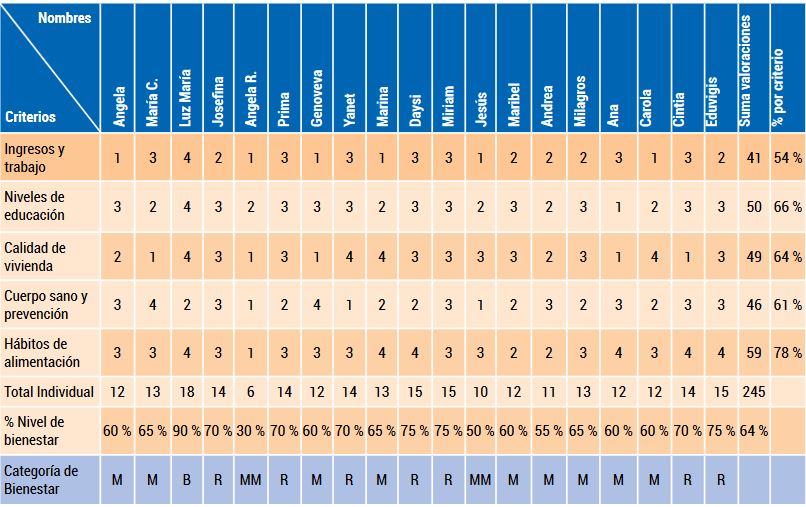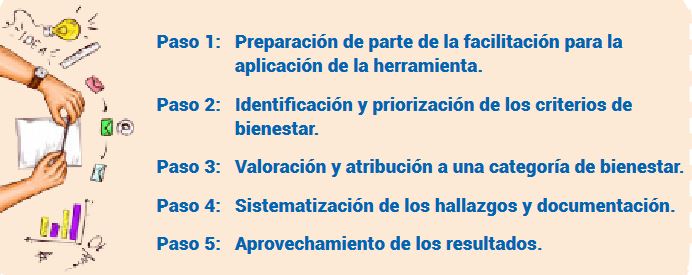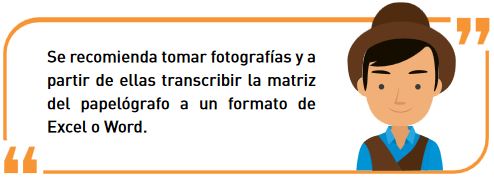Tool
HERRAMIENTA 1: ANÁLISIS DIFERENCIADO DE BIENESTAR - ADIB
NGO-IDEAs basically conceive of people with their visions, reflections and capacities to make decisions and face challenges. The Differentiated Analysis of Well-being – ADIB, is the first tool that defines well-being and measures it participatively
TOOL
2.1 ADIB concept: purpose, criteria and levels of well-being and poverty
Lorem fistrum por la gloria de mi madre esse jarl aliqua llevame al sircoo. De la pradera ullamco qué dise usteer está la cosa muy malar.
The ADIB refers to the analysis of well-being from the perspective of people, that is, of their subjective well-being from the identification of their criteria and dimensions of well-being and the differences that exist between families or households, or between people of a community or a group. It is a versatile instrument that can be adapted for specific diagnostic, self-assessment and analysis purposes.
As the first tool, in the concept of NGO-IDEAs, it appears as a starting point that will allow, among others, to better identify the options for change of individuals, families or specific groups. The level of well-being is measured, understood as the good life, the happy life, the good life, from a multidimensional perspective, in its sociocultural and local context. From this, its deficiency is identified, with the measurements and evaluations applied by the same people.
Contributing to the well-being, to the quality of life, to the fulfillment of the rights of specific groups is an objective of many development programs and it is the engine that motivates people to promote changes in their capacities, knowledge, attitudes and relationships. On the assessment of well-being depend the opportunities that people themselves perceive or want to propose as objectives of change, development, such as the expansion of their capacities.
There are many definitions of wellness, but the caveat is made that ADIB is not a scientific tool. By applying the ADIB tool, in the first place, it is identified, valued and reflected on people’s own perception, which in turn reflects their interests, needs and desires, and levels of knowledge. ADIB highlights the aspects valued and desired by people.


The assessment of the levels of well-being is based on the existing knowledge of the people and the experiences of the community, and helps the group to be aware of its potential and the obstacles that exist to their well-being. The ADIB allows us to see which households are most in need and motivates the community to seek solutions to overcome poverty. It is a tool that makes it easy for the NGO to classify the households of community members into various categories of well-being.
The application is at the same time a meeting point between the strategy of a project and the perception of a community about its imaginaries, visions of change and human development. For this, it is necessary for the NGO team to have knowledge and facilitation skills and the concept that underpins the application of NGO-IDEA tools.
NGO teams facilitate the application of the tool so that families or specific individuals become aware of their vision of well-being. The application of the tool helps also to understand the factors that are linked to higher levels of poverty and to prioritize those that help families move towards higher levels of well-being.
Tool 2.2 Propósitos y modalidades de aplicación del ADIB
The ADIB can have several objectives and purposes, be it for an NGO, a specific project or for the people of its target group, with the motivation to seek changes in their quality of life.
Entre los propósitos posibles para las ONG están:
- Get to know better the groups you work with, their characteristics and differences.
- Increase your awareness of the main factors that influence well-being and quality of life in a community or geographic area.
- Identify vulnerable people or households that will be included in the project strategy and coverage, and the most vulnerable aspects of the families or households to adjust the project strategy.
- Establish a wellbeing profile and identify social mobility from one poverty level to another.
- Provide information for planning and setting appropriate goals for poverty reduction.
- Contribute information for the baseline as part of a monitoring system from the welfare / poverty classification.
- Ensure that the poorest or most marginalized households benefit at least as much from the project as those who are better off.
For people who are members of a group or a community:
- Raise awareness about what factors condition and influence the improvement of their living standards.
- Motivate to plan and make decisions about change priorities and own commitments to assume.
- Raise awareness and create a feeling of support among members of a group regarding specific vulnerability factors and the inclusion of poorer people in the project as well as those who are in a better situation.
Tool Application modalities
According to the specific purposes, there are basically two ways of conducting the application of the ADIB tool. In both cases, facilitation is required that knows the context and has a relationship with the people.


Mode 1
The assessment from key actors, people who know the group or the people / families (more analytical).
Modality 1. Through key actors:
Key actors can be leaders, people who know families well, and members of a group or community. They use their knowledge and their criteria to classify the ranges of well-being or poverty. They can be supported by other tools, such as a community map, a diagnosis, existing statistics or surveys that they may have previously conducted and are, for example, available on the database NGO data.
In Mode 1 take into account:
- Select key informants who represent all sectors of the community. Form at least three small groups (of three people, for example) of informants representing different socioeconomic sectors of the community. Of them, by at least one group should be made up of women and, if possible, a group made up of young people.
- Prepare a preliminary list of households that contains at least the names of the persons who are heads of the household. The NGO needs basic information about households (community survey or social mapping).


Mode 2
Self-assessment with subjective appraisals about one's own quality of life and criteria of well-being or exclusion (more conscientious).
Mode 2. Self-assessment:
The same members of the community, a group or a specific target group of a project carry out a self-assessment of their level of well-being, through discussion among people and in dialogue with the facilitators. Mechanisms and spaces for reflection can be created to correct or validate self-assessment.
Lorem fistrum por la gloria de mi madre esse jarl aliqua llevame al sircoo. De la pradera ullamco qué dise usteer está la cosa muy malar.
In Mode 2 take into account:
- The ADIB can be done with people with whom the project works, or with people with whom the NGO does not yet work. In this case, consider the risk of generating expectations.
- With this tool, the well-being of the community can be analyzed more broadly by comparing the situation of a person with that of other members of the same community.
- The ADIB can be carried out based on the well-being of the whole family, but also on the specific situation of each of its members (young people, women).
- Always consider how people will assume self-worth taking into account the local culture.
2.3 The ADIB matrix: criteria and levels of well-being
The factors that influence well-being, quality of life or the specific situation that the group wants to analyze are called «well-being criteria» and must be identified in order to establish the ADIB matrix. In the facilitation, the well-being criteria are first established and then reflected with the group to see what the levels are for each criterion. This can occur as shown in the following example
Table Nº 2. Example of criteria and levels of well-being
Generating question: at what level of well-being is the family / household?
CRITERIA
HEALTH
OKAY
They always take their boys and / or girls to their check-ups.
REGULAR
Sometimes they take their boys and / or girls to their check-ups.
BAD
They take their children to their check-ups only when they are sick or ill.
VERY BAD
They never take their boys and / or girls to their controls.
NUTRITION
OKAY
The family eats well
REGULAR
The family eats regularly.
BAD
The family eats poorly.
VERY BAD
The family eats very poorly.
EDUCATION
OKAY
Parents always play with their sons and daughters.
REGULAR
Parents sometimes play alone with their sons and daughters.
BAD
Parents play very little with their children
VERY BAD
Parents never play with their children.
PROTECTION
OKAY
The family ensures that all the rights of children are fulfilled.
REGULAR
The family enforces most of the rights of children.
BAD
The family enforces some of the rights of children.
VERY BAD
The family does not fulfill any rights of children
The ADIB matrix in the first row shows the names of the people, followed by other additional information (for example, their age, gender, community, etc.)
Each criterion can have several levels: very good or rich, good, fair, poor or little well-being, extreme poverty, for example. Instead of the numbers, the levels can also be symbolized with «little faces», that is expressions of a happy or sad face, etc. For example, table No. 4 has been initially prepared using smilies, which have later been replaced by their equivalents in numbers in order to facilitate calculations.
The criteria established above are placed in the first column. Each person identifies the situation of his family, her home or his own and assesses it according to previously defined levels.
Table Nº 3. Example of an ADIB matrix


Leyenda


Table Nº 4. An example of an ADIB matrix with four levels expressed by symbols


Legend


The individual results are added together and kept in absolute numbers or calculated as percentages of an “ideal” total (see tables Nº 3 and Nº 4, respectively). Categories are established that can maintain the same intervals by score levels (see legend of table No. 3) or can establish other equivalences (see legend of table No. 4), always with prior understanding and agreement with the participants about the categories and their meaning.
The group analyzes the differences that exist in their levels of well-being based on the sums (or percentages) of their personal evaluations. By counting the people in each category, a summary of the well-being situation of the people in the group can be made, as in tables 3 and 4.
2.4 Sequence of application, facilitation and systematization of ADIB results
The sequence is the same in both modes:


STEP 1: Preparation of part of the facilitation for the application of the tool.
For the application of this tool, the facilitators need to carry out a set of previous activities that guarantee the success of the application.
STEP 1: Preparation of part of the facilitation for the application of the tool.
For the application of this tool, the facilitators need to carry out a set of previous activities that guarantee the success of the application.
Investigate and document
Previous review of existing documents, data, statistics. May include community tours and community transects or maps or consider to be done with participants later
Select key stakeholders
Selection of the people and / or key informants who will be summoned. The general well-being of a home or family can be analyzed, or it is also possible to focus directly on specific people or groups; for example: youth or women
Prepare the methodological note
The methodological note that will guide the facilitation of the application must include duration (3-4 hours recommended), objectives, sequences, and role-sharing among facilitators.
Summon and prepare logistics and materials
Invitation to participants and preparation of logistics and material with the objective and description of the tool, flip charts for the visualization of the ADIB with the group, as well as rectangular cards and markers.
STEP 2: Identification and prioritization of well-being criteria.
It is recommended that the facilitation be carried out by two people previously trained in the concept and tools of NGO-IDEAs.
- It begins with the introduction and explanation of the tool and the objectives of the activity.
- Next, a generating question is posed that will guide the discussion around what is specifically interesting to analyze based on the project, its strategy and the composition of the target group. Well-being of whom or whom?
It depends on how the generating question is formulated and that in turn depends on the main theme of the strategy or the character of the group.
The generating questions could be:
- Well-being, youth and social vulnerabilities. What influences that young people have a high level of well-being and low vulnerability in this neighborhood? To what extent do you have access to each of your rights?
- Well-being and rural family. What is a family that has a high level of well-being like in this community? What is a family like whose members are in extreme poverty? What conditions so that the members of a rural family here can advance in their quality of life or in their food security?
- Well-being and empowerment of women. What capacities and attitudes have women who make decisions, defend their rights and have achieved empowerment?
- Well-being and education. What capacities and characteristics must a family have so that their children can advance in their studies and have the support of their parents? What are families like where children do not continue in school, repeat, drop out, do not learn or advance?
- Wellness and health. What are the characteristics of the families with better health, nutrition and family planning habits in men and women? How are the families where family planning and reproductive health is practiced?
The generating question should lead to the identification and prioritization of four, five or six different criteria. Poverty and well-being should not be understood solely in economic terms. The generating question helps to find and discuss the criteria of well-being, quality of life or poverty. Well-being criteria vary according to local context and culture, but also according to age or gender.
Possible criteria to be identified.
- Knowledge and skills for the job.
- Housing conditions.
- Healthy habits.
- Food availability during the year.
- Job opportunities.
- Access to land for production.
- Food production.
- Coexistence relationships in the family.
- Non-violent collaborative relationships in the community.
- Family planning and reproductive health. Access to rights
Añade aquí tu texto de cabecera
It should be remembered that the levels of well-being should be established as shown in the example in Table 2. The group discusses and determines which levels of each criterion are typical in their community. A scale of one to four or one to five can be used, (a scale of one to three is not recommended), and possibly with symbols.
Once the levels have been determined, the situation of each person, family or household is evaluated. It must be remembered that the assessment of well-being can be done both with key actors and through self-application. In both cases, the levels of well-being or poverty are determined, without going into much detail about the situation of each person.
The matrix makes it possible to convert qualitative information on conditions and capacities for human development into quantitative and comparable information. They are simple operations of additions and average or percentage calculations that allow you to compare the different levels of well-being. This comparative analysis consists of the greatest wealth of the tool.
To consider:
- For each name there will be a column and for each criterion, a row (see example in Table Nº 3).
- Important characteristics can be attributed to each name in the context of the project. It can be the age of the person, their level of education, employment, gender, etc.
- Each person is assigned a level of well-being by criteria. If the criterion is not applied for any reason, as is the case of Kevin and Juana's families in Table No. 3, who do not have school-age children, an alternative is established, such as Not Applicable (NA
- At the end, the degree of well-being is recorded based on the sum of the score achieved. To do this, take into account the NA cases in the sum of criteria.
- One of the facilitators should help to make the calculation; other people in the group can help with that too.
- Another facilitator should take notes of the discussion, either on a flip chart or in their notebook because not only the numbers are important, but also the examples and explanations provided by the group.
- From the valuation of all of them, it is possible to calculate sums and averages of both horizontal and vertical values as seen in this example. It is also possible to calculate the percentages (indicating degrees of achievement of the objectives).
- De esta manera se hacen comparables los resultados de las personas, hogares y criterios. ¿En qué criterio se está en mejores situaciones? ¿En qué criterio se está mal? ¿Qué diferencias hay?
- It is also possible to analyze the differences between the members of a group, between families and households that share similar conditions. What people or households live in situations of greater well-being, with a higher quality of life or less vulnerability? Who are the worst offenders?
- In any case, from there a dialogue about the causes can be achieved. What could be the causes of the differences between people with a higher score and a lower score?
STEP 4: Systematization of the findings and documentation.
After the joint activity, the facilitators and the NGO team systematize the activity, its findings and document the ADIB.


The systematization should be done as soon as possible after the application of the tool and includes the interpretation of the results and conclusions, from the perspective of the NGO or project.
- 29TOOLBOX FOR PARTICIPATORY MONITORING OF EFFECTS AND IMPACTS STEP 4: Systematization of findings and documentation. After the joint activity, the facilitators and the NGO team systematize the activity, its findings and document the ADIB. The systematization should be done as soon as possible after the application of the tool and includes the interpretation of the results and conclusions, from the perspective of the NGO or project. Identify the decisive factors, the necessary solidarity practices and discuss the consequences for the formation of the group, the strategy and / or methodology of the project and the necessary adjustments.
- In the case of self-assessment, it is important that the group have a copy and keep their results.
- The NGO draws up a summary of the results and levels of well-being differentiation: which people, according to the sum of their level score, are in each category?
MB = Very low
Names and number of people
B = Low
Names and number of people
R = Regular
Names and number of people
B = Good and Very good
Names and number of people
PASO 5: Aprovechamiento de los resultados.
The results of the ADIB analysis can be a basis for the identification of individual or group change objectives by applying the NGO-IDEAs Individual Change (CI) or Collective Change (CC) tools. In the ARCO tool, the ADIB results will be used for the differentiated analysis of well-being.
Consider that:
- They can also be used to support a community plan or a strategic plan of a group, an association etc.
- The conclusions of the systematization shed light on how to use the results, the findings and the reflection processes created.
- The confidentiality of the informants must be guaranteed. This means that the data is encrypted before it leaves the NGO. When data is aggregated or results are published, it should no longer be possible to identify the reporting individuals.
2.5 Alternatives and special situations
- An ADIB with illiterate people. If working with self-assessments, the criteria can be expressed through a drawing; the symbols of "happy faces" can help the expression of values. Also between people can help in the discussion.
- An ADIB with children. You can use stories and introduce activities with pictures to help them express their own perceptions. Also incorporate playful activities to allow breaks between moments of analysis.
- An ADIB on children with key informants. Key informants who know the children well can be involved. For example, with parents, the generating question can be formulated in such a way that they pay attention to the conditions and factors of well-being that, for example, allow the proper development of their children. Teachers in a school or class can conduct an ADIB as key informants for their students.
- An ADIB with officials from a State office. For example, from a health center or with the teachers of a school. The analysis of well-being is made based on your condition and quality of work, adapting the generating question: what are the personal factors and conditions, in your institution, that determine that you can do your job well and provide a good service?
Specific sequence with key informants that is also used to generate the well-being criteria.
Having identified the key stakeholders, they are asked to classify the households according to their welfare situation, comparing them with each other (each household named on a card).
- At least three groups of key informants (eg, men, women, youth) meet separately and classify the cards into different groups according to well-being categories. They begin by forming a sequence with the cards; households with a similar welfare situation are grouped together. Five to eight categories can emerge.
- The cards can be regrouped into four or five categories. The informants then put a name or label on each category (for example: very poor, poor, in basic subsistence, in initial prosperity, in established prosperity) and explain what those characteristics consist of.
- The results must be validated by discussing them and cross-checking them with other members of the community. The results can be discussed in community meetings.
Individual assessment based on pre-established well-being criteria. Facilitators introduce, explain and reflect together on each of the criteria and categories of high well-being, regular well-being, discomfort and extreme discomfort. They are then attributed to households based on the determined criteria.
- This procedure can be based on the experiences of the NGO, which represents a time saving. It can also be worked out in advance with representatives of the groups, if they are organized.
- The advantage is that the aggregation of the results will be easier. The downside can be decreased participation, so a transparent and participatory process is recommended for this option.
2.6 Timing of an ADIB in a project cycle
When will it be appropriate to apply the tool? There are many possibilities to apply the tool and to take advantage of the information and analysis generated.
Antes del inicio del proyecto.
Depending on the cycle of a project, a very opportune moment may be before the initiation of the project, in its design or planning phase.
- To identify the target groups of a project or the most vulnerable people, to integrate them into the project.
- As part of the diagnosis and situational analysis phase.
- To determine the baseline of a project.
- To broaden target groups based on specific characteristics of vulnerability and poverty
- Cuando se inicia la elaboración del sistema de monitoreo.
Durante el ciclo de un proyecto.
If the project has already started its operating processes or if the strategies are already defined, there is also the possibility of starting NGO-IDEAs processes, as well as starting the use of the ADIB tool with a group, several groups, or with new ones. communities.
- When there is a need to deepen empowerment processes.
- When you want to have the security of having integrated the most needy into our project activities,
- When you want to improve the monitoring system, orient the project management towards effects and impacts or when making an evaluation.
- When you want to compare the well-being of different groups, sets of people or communities with respect to some well-being criteria.
Al final del proyecto (o ex post).
- In the final monitoring or evaluation of the project, the ADIB can be reapplied with the groups with whom it has worked during the implementation phase of the project.
- In this way, it is possible to find out how much the levels of well-being or access to certain rights have changed, and even if people’s perception of well-being has changed.
2.7 Ejemplos de ADIB y del análisis diferenciado de personas y hogares
The reflection on the criteria that mean that a family or person lives well or lives in extreme poverty can be visualized in a simple grouped list of the criteria mentioned by the participants, it can also -with more time- become a matrix that shows specific situations for each criterion. The following table shows an example of the establishment of well-being criteria and the specific situations at each level of well-being or poverty.
Table Nº 5. Criteria and levels of well-being
WELFARE AND POVERTY CRITERIA
1. Employment and income-generating work (urban)
4 = Very good
– Adults with work
– Good management
– Savings, investment
3 = Good
– Sufficient income for children’s studies
– Woman with own income
2 = Little / Regular
– Not enough income to study children
– Remittances
1 = Low
– Irregular work
– Children work
WELFARE AND POVERTY CRITERIA
2. Land and resource for production (rural)
4 = Very good
– More than 80 tasks
– Hired labor
– Technology
3 = Good
– 50 tareas
– Acceso al crédito
– Mujeres con su
propia producción
2 = Little / Regular
– 25 tasks but no funding
– Young people / Informals migrate
1 = Low
– No land
– Day laborers
– Young people migrate
WELFARE AND POVERTY CRITERIA
4. Housing quality Access to quality water
4 = Very good
– Houses of good material
– Electricity and complete sanitary services
– Good ubication
3 = Good
– Good apartment
– Separate rooms
– Bath
– Electricity
2 = Little / Regular
– Wood and zinc
– Latrine
– Cement floor
– Wood stove
1 = Low
– Borrowed house
– Risky location
– dirt floor
– Wood stove
– No latrine
WELFARE AND POVERTY CRITERIA
5. Access to health and healthy habits
4 = Very good
– They exercise and have healthy lifestyle habits
– All members have social and health insurance
3 = Good
– Access to medicines
– Youth and children with health care
2 = Little / Regular
– They live far away
– They don’t have insurance or money
– Addictions
1 = Low
-Medicine
– Illness
– Mental problem
– Does not participate due to health problems
WELFARE AND POVERTY CRITERIA
6. Food quality Sufficient access to food
4 = Very good
– Sufficient balanced diet
– Awareness of man and woman
3 = Good
– They produce food
– Food hygiene
2 = Little / Regular
– Men don’t know
– Money is not enough
– They don’t eat together
– Not enough vitamin
1 = Low
– Big Scrap
– Malnourished children
– Sometimes during the day
WELFARE AND POVERTY CRITERIA
7. Coexistence and values Investment of money in family priorities
4 = Very good
– There are resources for fun together
– No violence
– H and M make decisions
3 = Good
– Bad habits are avoided
– Mutual support
– Children speak with confidence
2 = Little / Regular
– H do not contribute to the family’s food
– Violence
1 = Low
– Sexism
– Neither H + M + youth participate
– Pregnant teenage daughters or with children
WELFARE AND POVERTY CRITERIA
8. Degree of participation in the community
4 = Very good
– They are honest
– H + M + young people contribute to solve problems
3 = Good
– H support M to participate
– They know well about proposals for improvements in the community
– Participate in activities
2 = Little / Regular
– 1 person from the household participates passively
– There are no democratic practices to resolve issues
1 = Low
– No member participates in activities



